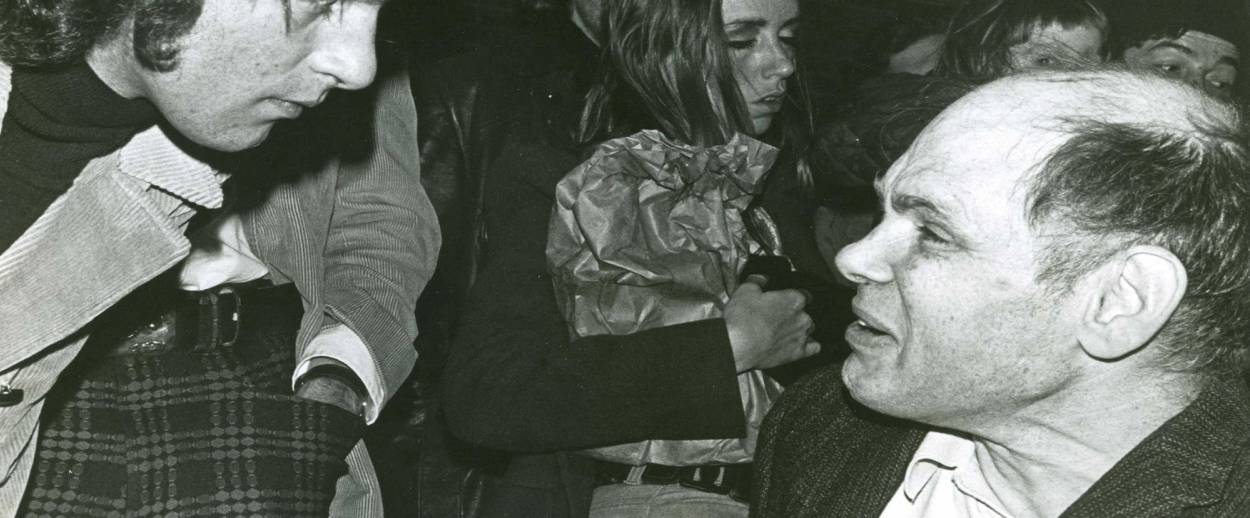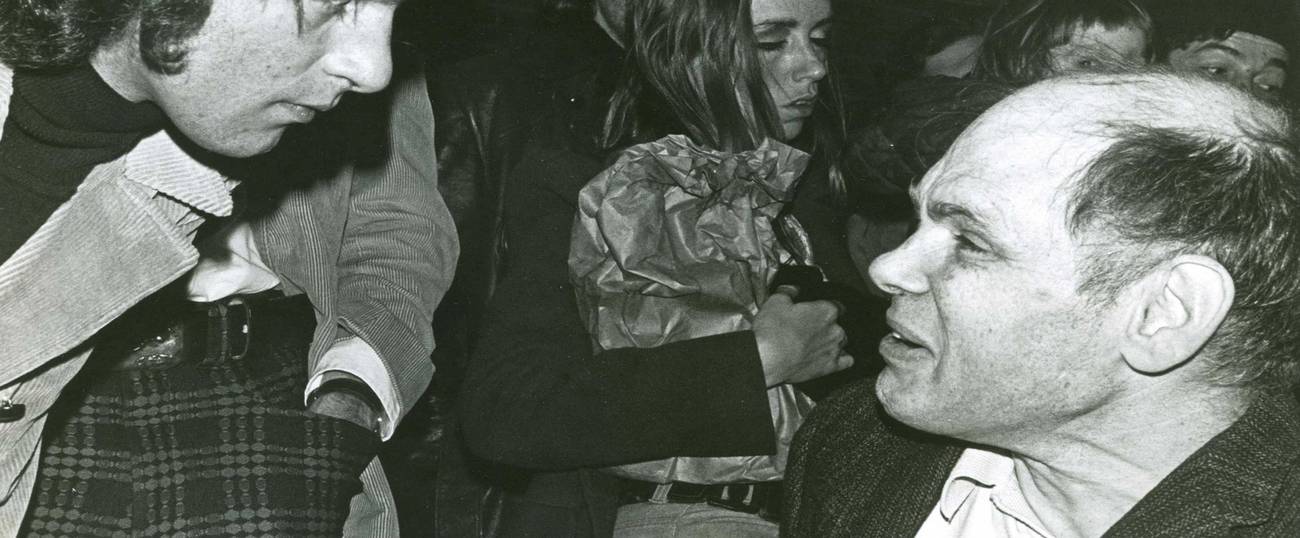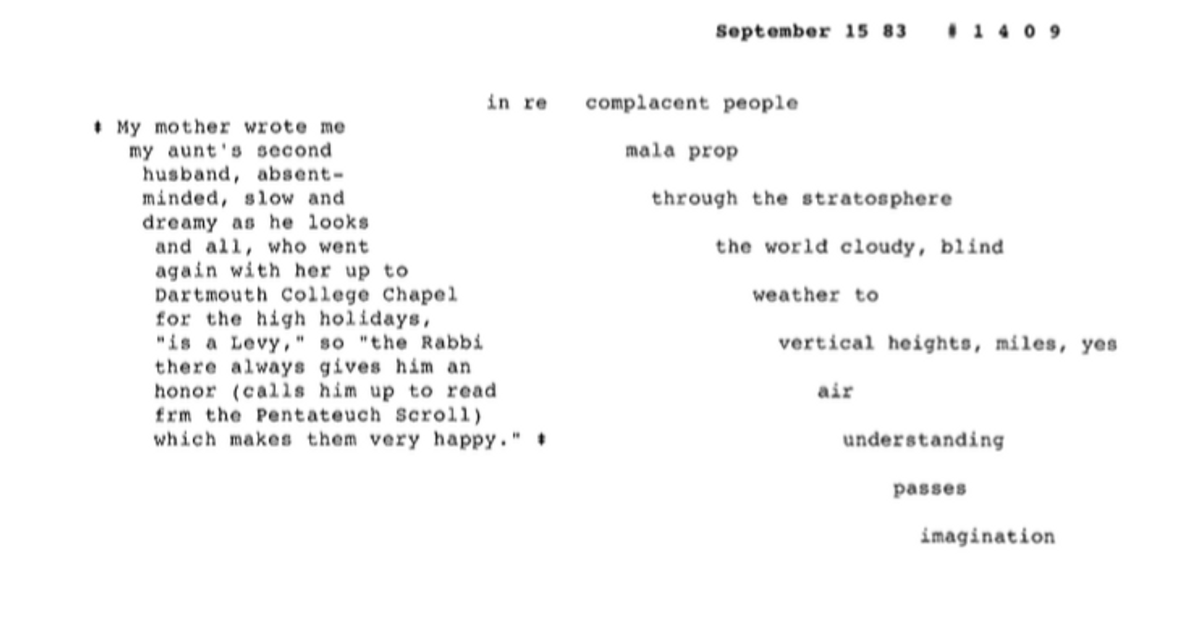Black Mountain Bar Mitzvah Poems
Should Larry Eigner’s work be read through the lens of his palsy?




Mystery and skepticism, spirit and philosophy, science, lyricism, and the vernacular all coalesce within this two-liner. Like thousands of Larry Eigner’s other works, this poem was typed on a Royal typewriter—a bar mitzvah gift—that throughout Eigner’s life remained a preferred mode of composition. Born with severe cerebral palsy, Eigner had very limited control over much of his body and typed with his right index finger while using the thumb for the space bar. In the breakthrough collection Calligraphy Typewriters: The Selected Poems of Larry Eigner, editors Curtis Faville and Robert Grenier closely replicated the author’s original typewritten text.
Indeed, in the poem above, the layout is significant. The relationship between the two tersely described images, thus positioned, turns theological. The stanza defies the typical left-justified margin, and the text hangs suspended in the space of the page, as if in the space of one mind’s cosmic probe. Condensation of the “black hole”—and the inescapable pull of its gravity—contrasts with the edifice of the divine powerhouse, its elements spread out or strewn, star-like. The opening image, though mostly blocked by the second, remains visible. The second image, as it concludes the poem, gives birth to its thereafter—the universe of interpretations, which this very article is a part of.

Eigner’s work is central to the legacy of the Black Mountain Poets—a revolutionary midcentury American collective. Additionally, in his later years, Eigner was embraced by L=A=N=G=U=A=G=E poets, one of the most influential experimental poetry groups of the last few decades. Eigner, author of 75 collections and broadsides, kept an extensive correspondence with many of his peers, and his reach extended across the world of American poetry.
It is impossible, however, to think of Eigner’s work without the context of his own life’s circumstances. Eigner’s disability, which, in addition to severely limited mobility also included slurred speech, was the result of a doctor’s mistake during his birth. For 51 years, the poet was cared for by his parents, Bessie and Israel, in their home in Swampscott, Mass. One of Eigner’s greatest champions, editor Robert Grenier notes in a biographical sketch that the poet spent much of those first 51 years “in a space prepared for him on the glassed-in front porch (where he could observe & contemplate everything that was going on, within the range of his seeing & hearing & imagining), basically every day.” Due to his parents’ efforts, through homeschooling, and tutoring, Eigner was able to finish a local high school, as well as seven correspondence courses through the University of Chicago.
After his father died, Eigner moved to Berkeley, California, to live in a home, as Grenier writes, “purchased by his then conservator, brother Richard Eigner, in the company of a household of persons (students, poets & their kids) who provided for his needs and included him in their daily lives.” During these years, Eigner became involved in the Bay Area poetry world, attending readings and gatherings and various other events.
The sort of poetry Eigner had chosen to write was neither confessional nor autobiographical—certainly not in the narrow, factual sense of that word. The specifics of the poet’s condition rarely appear in the poems themselves. The question Eigner’s readers may then ask is: How can one read Eigner’s work without reducing him to his disability—and, at the same time, read him without pretending to ignore the facts of the poet’s life that affected everything around him?
***
In his essay “Subliming the Sublime,” poet and critic Charles Bernstein suggests: “A worthwhile exercise is to read an Eigner poem with and then without the frame of his disability. This toggling will begin to activate his poetry’s 4-D potentiality (the fourth D being duration): The poems follow the modernist principle of imitating not the look but the conditions of nature and, as such, they are able to reflect serial projections without being determined by any one of them.” See, for instance, this poem:

The poem’s finale is a question, which has a very real, nonabstract significance for a person who’s spent much of his time in a wheelchair. Does the very word “movement” trigger a different set of psychological, even spiritual, meanings to someone who moves in a way that is markedly different from those around him? At the same time, the question of the meaning of time, and the struggle to comprehend it, is certainly universal. The few extra spaces between the word “sense” and “of moving” could signify one’s struggle with speech. More likely, though, it is a moment of contemplation, a timely pause needed to find the right word. It is as if the poet is searching for the word to describe the indescribable. He then decides that “movement” is the most-apt word for what he’s trying to articulate.
The poet is sitting, stationary—he is bound to do so more than others. At the same time, he is in a meditative stance, in which awareness of the particulars is heightened: he is keenly cognizant of his position in space in this given moment. The act of sitting with one’s back to the front door leads the poet to a personal or psychological realization: This is a retreat of a sort, a turning away from the world. The doubling of the word “inside,” reminiscent of the biblical Hebrew—which Eigner was familiar with, according to a 1994 interview with Jack Foley—intensifies the relationship between the depiction of the body’s position and the retreat “inside inside,” into one’s holy of holies—the inner sanctum where consciousness dwells. The movement across time, then, stands in juxtaposition with timelessness of inward-bound contemplation.
Poet and scholar Jennifer Bartlett, who is working on a full-length biography of Larry Eigner, pointed in an email to Eigner’s interest in Buddhism, which he encountered through his correspondence with poet Cid Corman. At the same time, Bartlett noted, Eigner’s family “attended services, observed Sabbath candle-lighting at home, and celebrated Jewish home-based festivals” even if, as Bartlett said, they “considered themselves more culturally than religiously Jewish.” There is no doubt that the poem above, in its focus on the singular moment as dictated by the immediate circumstances, is reminiscent of a haiku. In the following poem, this haiku-like tone is curiously juxtaposed with a narrative that evokes the marking of the High Holiday season:

These are not two separate poems. It is perhaps the epitome of what Ben Friedlander, poet and editor of a collection of Eigner’s prose writings, describes as the poet’s “abandonment of the left margin and subsequent break from a phraseology determined by normative habits of sentence construction.” Two stanzas exist side by side, as conflicting narratives often do in one’s mind. The sentence structure of the left stanza is traditional, and its left margin, though shifted, is rather rigid—suggesting, possibly, the rigidity Eigner associated with his relatives. The stanza on the right, however, wraps around, serving as both an alternative—and a hermeneutic—commentary, at once.
Friedlander writes that the “particularity of Eigner’s relation to language and to his environment plays a prominent role in his mature work. Both parents, for instance, came from immigrant families, and Yiddish (or ‘brochen English,’ as Eigner quotes his grandmother as saying), often spoken at the dinner table, led to a fascination with unusual or hybrid locutions.” The word “mala prop” is just such a locution: Thus split, the word may lead one to thinking of meditational mala beads—a meditational prop Eigner is metaphorically handling as he reflects on his mother’s letter. The final three words of the stanzas on the right are the most puzzling: Don’t the poets prize imagination above all else? Doesn’t imagination allow us to transcend it all? Perhaps, in the case of Eigner, the need to understand and be understood—through, undoubtedly, poetry—took precedence over imagery and lyricism.
One wonders whether Eigner’s physical condition should be a factor in how we read his poetry. Is there anything wrong, intrusive, or indelicate, about coming back to the poet’s disability? In an email, Eigner biographer Jennifer Barlett cautioned to avoid using such phrases as “wheelchair-bound, confined to a wheelchair, suffered from cerebral palsy.” As she clarified in a phone interview, “everyone suffers, experiencing pain,” and, however profound the effects, Eigner was not a victim of his condition, nor did the circumstances ultimately define him as a human being.
Can one’s quest for empathetic reading and understanding overstep the boundaries of decorum? Should such boundaries be relinquished in the quest for understanding? How much attention should one draw to the difference? The answers, ever-shifting, can perhaps be found teeming within this closing poem of Eigner’s. His lines stand at the edge of earnest questions and skepticism, binarism, and its affects, in a moment of the spirit’s unraveling:

Jake Marmer is Tablet’s poetry critic. He is the author of Cosmic Diaspora (2020), The Neighbor Out of Sound (2018) and Jazz Talmud (2012). He has also released two jazz-klezmer-poetry records: Purple Tentacles of Thought and Desire (2020, with Cosmic Diaspora Trio), and Hermeneutic Stomp (2013).